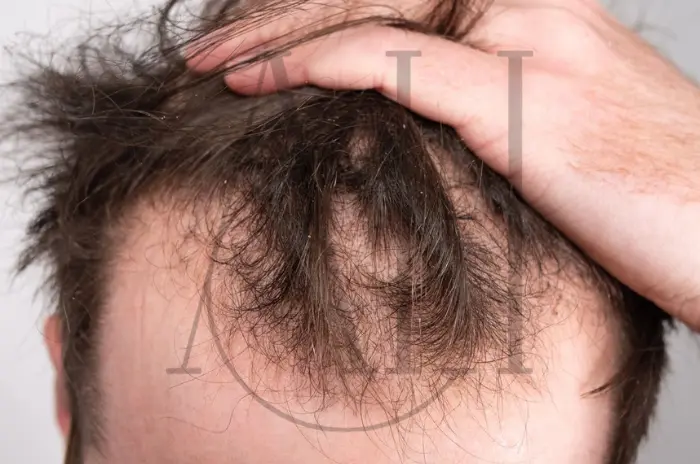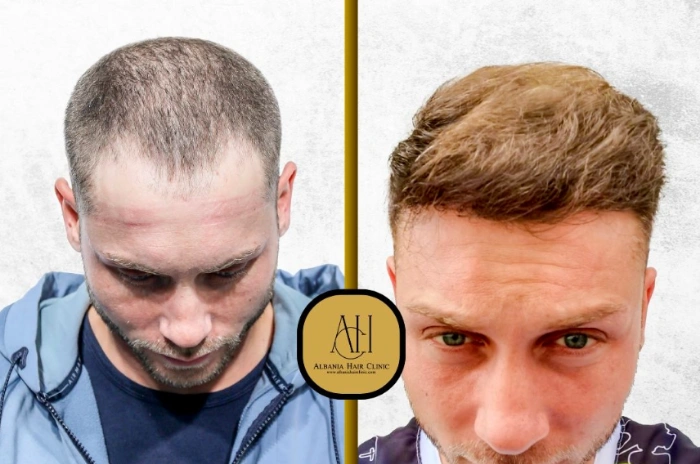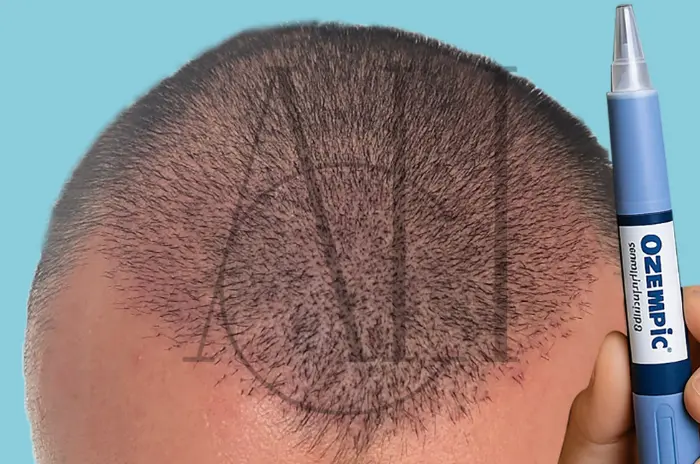Hair loss affects millions of people worldwide, impacting not only physical appearance but also self-confidence and quality of life. While the search for a definitive “cure” for baldness continues, recent scientific breakthroughs and advanced treatment options offer new hope for those experiencing hair loss. As an intermediary organization connecting patients with qualified hair specialists, Albania Hair Clinic stays at the forefront of emerging treatments and proven solutions for hair restoration.
Table of Contents
ToggleUnderstanding Hair Loss and Baldness
Hair loss is a complex condition with multiple underlying causes. Understanding these factors is crucial for developing effective treatment strategies and setting realistic expectations for recovery.
What Causes Hair Loss?
Hair loss can result from various factors, often working in combination to create visible thinning or baldness. The most common causes include:
Androgenetic Alopecia (Pattern Hair Loss):
- Affects 95% of men and 40% of women experiencing hair loss
- Caused by sensitivity to dihydrotestosterone (DHT)
- Results in gradual thinning and eventual baldness in susceptible areas
Medical Conditions:
- Alopecia areata (autoimmune hair loss)
- Thyroid disorders
- Scalp infections
- Trichotillomania (hair-pulling disorder)
External Factors:
- Medications and medical treatments
- Physical or emotional trauma
- Nutritional deficiencies
- Excessive hairstyling or chemical treatments
The Link Between Stress and Baldness
Stress plays a significant role in hair loss through several mechanisms:
Physiological Impact: Chronic stress elevates cortisol levels, which can disrupt the hair growth cycle and push follicles into the resting phase prematurely.
Immune System Effects: Prolonged stress can trigger autoimmune responses, potentially leading to conditions like alopecia areata where the body attacks its own hair follicles.
Behavioral Consequences: Stress often leads to poor dietary choices, sleep disruption, and harmful habits like hair pulling, all of which can contribute to hair loss.
Hormonal Imbalances and Hair Thinning
Hormones regulate hair growth cycles, and imbalances can significantly impact hair health:
- DHT sensitivity: The primary culprit in male pattern baldness
- Estrogen fluctuations: Common during menopause, pregnancy, and hormonal therapy
- Thyroid hormones: Both hyperthyroidism and hypothyroidism can cause hair loss
- Insulin resistance: Can affect hair follicle health and growth patterns
Effective Treatments to Cure Hair Loss
Modern hair loss treatment encompasses a range of approaches, from natural remedies to cutting-edge medical interventions.
Natural Remedies to Regrow Hair
While natural treatments may not provide dramatic results for severe hair loss, they can support overall hair health:
Scalp Massage and Essential Oils:
- Rosemary oil has shown promise in clinical studies
- Peppermint oil may improve circulation to hair follicles
- Regular scalp massage can stimulate blood flow
Nutritional Support:
- Biotin supplementation for hair strength
- Iron and zinc for optimal follicle function
- Omega-3 fatty acids for scalp health
- Protein intake to support hair structure
Herbal Remedies:
- Saw palmetto may help block DHT production
- Green tea contains antioxidants that support follicle health
- Ginseng has been studied for its potential hair growth properties
Medical Solutions for Baldness
Evidence-based medical treatments form the backbone of effective hair loss management:
FDA-Approved Medications:
| Medication | Type | Effectiveness | Side Effects |
|---|---|---|---|
| Minoxidil | Topical vasodilator | 30-40% regrowth rate | Scalp irritation, unwanted facial hair |
| Finasteride | DHT blocker | 80% stabilization rate | Sexual side effects (rare) |
| Dutasteride | Dual DHT blocker | Higher efficacy than finasteride | Similar to finasteride |
Advanced Medical Procedures:
- Platelet-Rich Plasma (PRP) therapy
- Low-Level Laser Therapy (LLLT)
- Microneedling with growth factors
- Stem cell treatments (experimental)
Topical Treatments and Their Effectiveness
Topical solutions offer targeted delivery of active ingredients directly to affected areas:
Minoxidil Formulations:
- 2% solution for women
- 5% solution for men
- Foam formulations for easier application
- Combination products with additional active ingredients
Prescription Topicals:
- Tretinoin to enhance minoxidil absorption
- Azelaic acid for DHT blocking
- Ketoconazole for antifungal and anti-inflammatory effects
Preventing Hair Loss Before It Starts
Prevention strategies can significantly reduce the risk of hair loss or slow its progression when implemented early.
Diet and Lifestyle Changes for Healthy Hair
Optimal nutrition and lifestyle habits create the foundation for healthy hair growth:
Essential Nutrients for Hair Health:
- Protein: 46-56 grams daily for adequate hair structure
- Iron: Particularly important for women of reproductive age
- Vitamin D: Supports follicle health and hair cycling
- B-complex vitamins: Essential for cellular metabolism
Lifestyle Modifications:
- Regular exercise to improve circulation
- Stress management through meditation or therapy
- Adequate sleep (7-9 hours nightly)
- Avoiding smoking and excessive alcohol consumption
Early Signs of Hair Thinning to Watch For
Recognizing early warning signs allows for prompt intervention:
- Increased hair shedding (>100 hairs daily)
- Gradual widening of hair part
- Miniaturization of hair strands
- Changes in hair texture or growth rate
- Visible scalp through hair coverage
How to Strengthen Hair Follicles Naturally
Supporting follicle health through natural methods can help maintain hair density:
Scalp Care Routine:
- Gentle cleansing with sulfate-free shampoos
- Regular deep conditioning treatments
- Protection from UV damage and environmental stressors
- Avoiding tight hairstyles that create tension
Blood Circulation Enhancement:
- Daily scalp massage for 5-10 minutes
- Inversion exercises to increase blood flow
- Hot/cold therapy to stimulate circulation

Can Baldness Be Reversed or Cured?
The question of whether baldness can be truly “cured” requires understanding the complexity of hair loss and the limitations of current treatments.
Understanding the Hair Growth Cycle
Hair growth occurs in distinct phases that determine treatment effectiveness:
| Phase | Duration | Characteristics | Treatment Implications |
|---|---|---|---|
| Anagen | 2-6 years | Active growth phase | Most responsive to treatments |
| Catagen | 2-3 weeks | Transitional phase | Limited treatment response |
| Telogen | 2-3 months | Resting phase | Hair shedding occurs |
Treatment Timing: Interventions are most effective during the anagen phase when follicles are actively producing hair.
Why Current Treatments Often Fail
Several factors contribute to treatment limitations:
Individual Variation: Genetic differences affect treatment response rates significantly. What works for one person may not work for another due to genetic polymorphisms affecting drug metabolism and receptor sensitivity.
Progression of Hair Loss: Advanced baldness with extensive miniaturization may be irreversible, as severely damaged follicles cannot regenerate healthy hair.
Compliance Issues: Many treatments require consistent, long-term use to maintain benefits, and discontinuation often leads to renewed hair loss.
Unrealistic Expectations: Treatments typically slow progression or achieve modest regrowth rather than complete restoration to original hair density.
The Role of JAK Inhibitors in Curing Hair Loss
JAK inhibitors represent a promising new class of treatments, particularly for autoimmune forms of hair loss.
What Are JAK Inhibitors and How Do They Work?
JAK (Janus Kinase) inhibitors are medications that block specific enzymes involved in immune system signaling:
Mechanism of Action:
- Block inflammatory pathways that attack hair follicles
- Reduce autoimmune responses in alopecia areata
- Allow dormant follicles to resume normal hair production
Available JAK Inhibitors:
- Baricitinib (FDA-approved for alopecia areata)
- Ruxolitinib (topical formulation)
- Tofacitinib (off-label use)
Evidence of Hair Regrowth in Alopecia Patients
Clinical trials have demonstrated significant efficacy for JAK inhibitors in treating alopecia areata:
- Response rates: 30-40% of patients achieve significant hair regrowth
- Time to response: Visible improvement typically within 3-6 months
- Maintenance: Continued treatment necessary to sustain benefits
- Side effects: Generally well-tolerated with monitoring
The Science Behind Curing Male Pattern Baldness
Recent scientific discoveries have revealed new mechanisms that could revolutionize hair loss treatment.
How Sugar Molecules Could Boost Hair Regrowth
Researchers have discovered that specific sugar molecules play crucial roles in hair follicle regeneration:
Glycosaminoglycan Research: Studies show that certain sugar-based molecules can stimulate dermal papilla cells, which are essential for hair follicle function and regeneration.
Clinical Applications: This research has led to the development of topical treatments containing these specialized sugar molecules, showing promising results in preliminary trials.
The Role of Dermal Papilla Cells in Hair Follicles
Dermal papilla cells serve as the command center for hair follicle activity:
Key Functions:
- Signal hair follicle stem cells to begin growth cycles
- Regulate the size and thickness of hair strands
- Determine the duration of growth phases
- Control follicle regeneration after damage
Treatment Implications: Therapies targeting dermal papilla cell function could potentially restore normal hair growth patterns even in severely affected areas.
Why This Discovery Changes Hair Loss Treatment
This scientific breakthrough represents a paradigm shift in hair loss treatment:
- Targeting Root Causes: Instead of just blocking DHT or stimulating circulation, new treatments address fundamental follicle biology
- Potential for Regeneration: Could enable true hair follicle regeneration rather than just preservation
- Broader Applications: May benefit various types of hair loss, not just androgenetic alopecia
Surgical Hair Loss Treatments
Surgical interventions remain the most effective option for advanced hair loss, providing permanent solutions through hair redistribution.
FUE Hair Transplant: How It Works and Results
Follicular Unit Extraction (FUE) is currently the gold standard for hair transplantation:
Procedure Overview:
- Individual follicles extracted from donor areas
- Minimal scarring and faster recovery
- Natural-looking results when performed skillfully
- Can transplant 1,000-3,000 grafts per session
Expected Outcomes:
- 90-95% graft survival rate
- Visible growth begins at 3-4 months
- Full results apparent at 12-18 months
- Permanent hair growth in transplanted areas
FUT Hair Transplant: Pros and Cons
Follicular Unit Transplantation (FUT) offers an alternative surgical approach:
| Advantages | Disadvantages |
|---|---|
| Higher graft yield per session | Linear scar in donor area |
| Lower cost per graft | Longer recovery time |
| Faster extraction process | Activity restrictions post-surgery |
| Suitable for extensive baldness | Less suitable for short hairstyles |
What to Expect from Hair Transplant Surgery
As an intermediary organization, Albania Hair Clinic ensures patients understand the complete transplant process:
Pre-Surgery Phase:
- Comprehensive consultation and planning
- Medical evaluation and clearance
- Detailed discussion of expectations and limitations
- Pre-operative instructions and preparation
Surgery Day Experience:
- Local anesthesia for patient comfort
- 6-8 hour procedure duration
- Real-time monitoring and care
- Immediate post-operative instructions
Recovery and Follow-up:
- Initial healing within 7-10 days
- Regular follow-up appointments
- Progress monitoring and documentation
- Long-term care recommendations
Non-Surgical Hair Loss Solutions
Non-surgical treatments offer effective alternatives for those seeking to avoid invasive procedures.
Minoxidil: Does It Really Regrow Hair?
Minoxidil remains one of the most studied and effective non-surgical treatments:
Clinical Evidence:
- 30-40% of users experience moderate to dense regrowth
- 80% see stabilization of hair loss
- Most effective on crown and vertex areas
- Results typically visible within 3-6 months
Mechanism of Action:
- Vasodilation increases blood flow to follicles
- Extends anagen (growth) phase duration
- May stimulate follicle miniaturization reversal

Finasteride: How It Stops Hair Thinning
Finasteride addresses hair loss at the hormonal level by blocking DHT production:
Effectiveness Data:
- 83% of men maintain their hair over 2 years
- 65% experience some regrowth
- Most effective in crown and mid-scalp areas
- Requires continuous use to maintain benefits
Considerations:
- Prescription medication requiring medical supervision
- Potential side effects in small percentage of users
- Not approved for use in women of childbearing age
- Results may take 3-6 months to become apparent
PRP Therapy for Hair Regrowth
Platelet-Rich Plasma therapy uses the patient’s own blood components to stimulate hair growth:
Treatment Process:
- Blood draw and centrifugation to concentrate platelets
- Injection of PRP into affected scalp areas
- Growth factors stimulate follicle activity
- Typically requires 3-6 treatment sessions
Expected Results:
- Improved hair density and thickness
- Reduced hair shedding
- Enhanced scalp health
- Results visible within 2-4 months
Is Hair Transplantation a Cure?
Understanding the limitations and realistic expectations of hair transplantation is crucial for patient satisfaction.
How Hair Transplants Work
Hair transplantation redistributes existing hair rather than creating new follicles:
Fundamental Principle: Healthy follicles from DHT-resistant areas (typically the back and sides of the head) are moved to balding areas where they continue to grow normally.
Permanence Factor: Transplanted hair maintains the characteristics of its donor area, making it resistant to further hair loss in most cases.
Why Transplants Are Not a Universal Solution
Several factors limit transplantation as a complete cure:
- Finite donor supply: Limited number of available follicles for transplantation
- Ongoing hair loss: Native hair may continue to thin around transplanted areas
- Coverage limitations: May not achieve original hair density
- Multiple procedures: Often requires 2-3 sessions for optimal results
What’s on the Horizon for Curing Baldness?
Emerging technologies and research developments offer hope for more effective future treatments.
The Potential of Stem Cell Therapy
Stem cell research represents one of the most promising avenues for hair loss treatment:
Current Research Focus:
- Adipose-derived stem cells for follicle regeneration
- Hair follicle stem cell activation
- Combination therapies with growth factors
- Scalp tissue engineering approaches
Clinical Trial Progress:
- Early-phase trials showing encouraging results
- Safety profiles being established
- Optimization of delivery methods
- Combination with existing treatments
How Hair Cloning Could Change the Game
Hair cloning technology aims to multiply hair follicles for unlimited transplantation:
Scientific Approach:
- Extraction and culture of dermal papilla cells
- Multiplication of follicle-producing cells
- Creation of new follicles for transplantation
- Potential for unlimited donor hair supply
Timeline and Challenges:
- Still in research and development phase
- Regulatory approval processes required
- Technical challenges in follicle recreation
- Estimated 5-10 years until clinical availability
Future Possibilities for Curing Baldness
The convergence of multiple scientific disciplines offers unprecedented opportunities for hair loss treatment advancement.
From Lab Research to Clinical Hair Treatments
The translation of research discoveries into practical treatments involves several critical steps:
Research Pipeline Stages:
- Basic science and mechanism discovery
- Preclinical testing in laboratory models
- Phase I safety trials in humans
- Phase II efficacy studies
- Phase III large-scale clinical trials
- Regulatory approval and market introduction
Current Promising Research Areas:
- Gene therapy for androgenetic alopecia
- 3D bioprinting of hair follicles
- Nanotechnology for targeted drug delivery
- Artificial intelligence for personalized treatment selection
What This Means for Male and Female Pattern Baldness
Advancing research specifically addresses the different patterns and causes of hair loss in men and women:
Male Pattern Baldness Advances:
- More targeted DHT blocking strategies
- Combination therapies for enhanced effectiveness
- Precision medicine approaches based on genetic profiling
Female Pattern Hair Loss Research:
- Hormone-specific treatment protocols
- Understanding of unique female hair loss mechanisms
- Development of female-specific formulations and dosages
Timeline for Developing New Hair Loss Therapies
Realistic timelines for emerging treatments help set appropriate expectations:
| Treatment Type | Current Status | Estimated Availability |
|---|---|---|
| Advanced JAK Inhibitors | Phase III trials | 2-3 years |
| Hair Cloning Technology | Preclinical research | 5-10 years |
| Gene Therapy | Early clinical trials | 7-12 years |
| Stem Cell Treatments | Phase II trials | 3-5 years |
| Bioengineered Follicles | Research phase | 10-15 years |
As an intermediary organization, Albania Hair Clinic emphasizes that while these developments are promising, patients should focus on currently available, proven treatments while staying informed about emerging options.
FAQ
What are the primary causes of hair loss and baldness?
The main causes include androgenetic alopecia (genetic sensitivity to DHT affecting 95% of male hair loss), autoimmune conditions like alopecia areata, hormonal imbalances, stress, medical conditions, medications, and nutritional deficiencies. Pattern hair loss is the most common type affecting both men and women.
Is it possible to completely "cure" or permanently reverse all types of baldness?
Currently, there is no universal “cure” for all types of baldness. Treatments can slow progression, achieve regrowth, or redistribute existing hair through transplantation, but most require ongoing maintenance. Some conditions like alopecia areata may resolve spontaneously, while androgenetic alopecia is typically progressive without treatment.
What are the most effective medical treatments recommended by dermatologists for hair loss?
The most effective treatments include minoxidil (30-40% regrowth rate), finasteride (83% maintain hair over 2 years), JAK inhibitors for alopecia areata, PRP therapy, and hair transplantation. Treatment selection depends on hair loss type, severity, and individual factors.
How do surgical options like FUE and FUT hair transplants work, and are they a "cure" for baldness?
FUE extracts individual follicles while FUT removes a strip of scalp tissue. Both redistribute healthy follicles to balding areas with 90-95% survival rates. They’re not a complete “cure” as they work with existing hair supply and don’t prevent future loss of native hair.
What is the role of JAK inhibitors in treating hair loss, especially for conditions like alopecia areata?
JAK inhibitors block immune system pathways that attack hair follicles in autoimmune hair loss. Baricitinib is FDA-approved for alopecia areata with 30-40% of patients achieving significant regrowth within 3-6 months. They’re most effective for autoimmune rather than androgenetic hair loss.
Are there any natural remedies or lifestyle changes that can help prevent or reduce hair loss?
Natural approaches include scalp massage, essential oils (rosemary, peppermint), proper nutrition (protein, iron, vitamins), stress management, adequate sleep, and gentle hair care practices. While supportive, these are typically insufficient for significant hair loss without medical intervention.
What new advancements and future possibilities are on the horizon for curing baldness?
Emerging treatments include stem cell therapy (3-5 years), advanced JAK inhibitors (2-3 years), hair cloning technology (5-10 years), gene therapy (7-12 years), and bioengineered follicles (10-15 years). Research into sugar molecules and dermal papilla cell stimulation shows promise for regenerative treatments.
When should someone seek professional help for hair loss, and what can they expect during a consultation?
Seek help when experiencing increased shedding (>100 hairs daily), visible thinning, or changes in hair texture. Consultations typically include medical history review, scalp examination, possible testing, treatment option discussion, and realistic expectation setting. Early intervention generally provides better outcomes.






